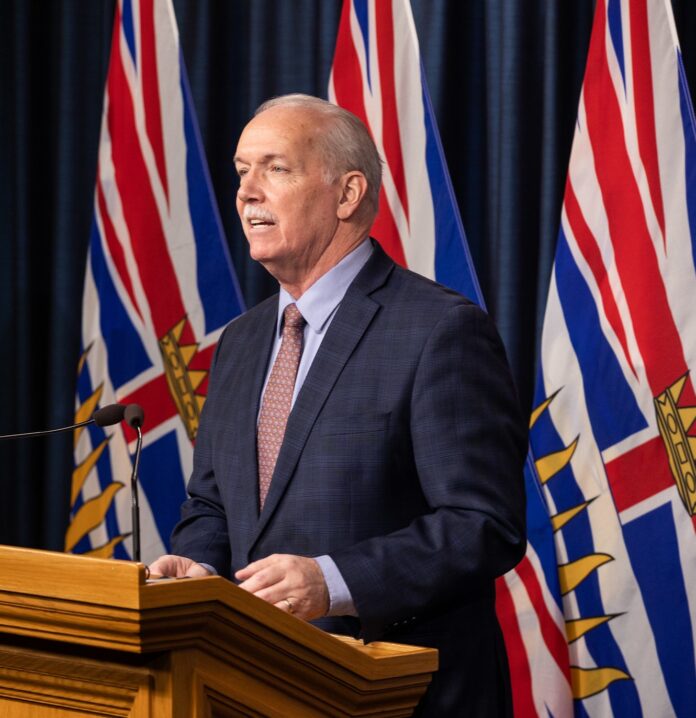THE Province, Doctors of BC, and BC Family Doctors have achieved a new payment model for family doctors to help protect, support and strengthen B.C.’s health-care system and patient care.
Under the new payment model, the Province will be better able to attract new family doctors to family practice and retain existing doctors.
“We know how important family doctors are in B.C.,” said Premier John Horgan on Monday. “Rising costs, pandemic-related pressures and staffing shortages required action for doctors on several fronts. Working with the Doctors of BC, I am pleased that we have come up with a new payment model that makes B.C. a province that attracts, retains and supports family doctors, and ensures they can focus on what matters most – providing care to patients when they need it.”
The new payment model, co-developed by Doctors of BC, BC Family Doctors and the Province, will be available to family doctors beginning February 2023.
It provides another option for family doctors that marks a departure from the fee-for-service model under which doctors are paid based primarily on the number of patients they see in a day. The new model takes into account factors including:
* the time a doctor spends with a patient;
* the number of patients a doctor sees in a day;
* the number of patients a doctor supports through their office;
* the complexity of the issues a patient is facing; and
* administrative costs currently paid directly by family doctors.
“In January, as our B.C. pandemic entered a new phase, we said it was time to renew, rebuild and strengthen our health-care system,” said Adrian Dix, Minister of Health. “And the actions we’ve been taking, including the new payment model, come from working so closely with Doctors of BC and BC Family Doctors to find solutions that strengthen our health-care system, that renew its essential function, and that build on our support for doctors and the patients who count on them. Today is about commitment, action, and collaboration, and all they make possible in our health-care system.”
This provides a more equitable payment for the work of family doctors and better recognizes their value in providing full-service primary care to patients. Full-service family doctors are those who work in communities to provide ongoing primary-care services to their patients. It will help maintain their business autonomy and give them more flexibility to create the kind of practice that works best for them and their patients.
The Province and Doctors of BC have also reached a tentative physician master agreement (PMA), which includes several commitments that will better support doctors as they care for their patients.
The new three-year tentative PMA drives continued collaboration by the Ministry of Health, physicians, Doctors of BC, and regional health authorities to achieve key priorities that improve health care, including gender equity, Indigenous reconciliation and workplace safety. It also addresses work completed after regular operating hours by advancing improvements to existing alternative physician payment contracts and increases.
“We are excited about these two major developments that we believe will make a real difference in helping to improve health care in B.C.,” said Dr Ramneek Dosanjh, President, Doctors of BC. “Over the last months, the provincial government has listened to the voices of physicians who passionately care about our patients. The new physician master agreement, which must be ratified by B.C.’s doctors, recognizes the value of the work doctors do every day. The new payment model option for family doctors is unique in Canada, bringing together the best of a range of payment methods. The goal is to not only stabilize longitudinal family practice, but to also make it sustainable and rewarding. Everyone deserves a family doctor, and this new option is a major step toward making that goal a reality.”
Improving and increasing access to health services for patients will continue to be the focus of Doctors of BC and Ministry of Health working groups over the coming months. This includes how best to attach patients with complex needs, a provincial rostering system to ensure patient care continuity, a provincial patient survey and how best to incorporate into the new model other services that family doctors provide outside of clinics. These efforts are part of a re-focusing of B.C.’s primary-care strategy.
The Province said that this announcement also builds on the commitment made in May by Horgan and Dix to work with Doctors of BC on a multi-phased approach to help protect and strengthen B.C.’s health-care system. In August, the Province announced stabilization funding of $118 million to support family doctors with overhead costs.
On Monday, October 31, 3,164 family doctors are to receive $107 million in stabilization payments.
The new payment model is part of B.C.’s Health Human Resources Strategy announced on September 29. This strategy puts patients first by ensuring they get the health services they need and are cared for by a healthy workforce. It focuses on 70 key actions to recruit, train and retain health-care workers, while redesigning the health-care system to foster workplace satisfaction and innovation.
Learn More:
To learn more about Doctors of BC, visit: https://www.doctorsofbc.ca/
BACKGROUNDER 1
New tentative physician master agreement
* Most physicians are independent contractors. Their services are paid for through fees, contractual arrangements and other incentive programs negotiated in the physician master agreement.
* Unlike public-sector employees, physicians are typically responsible for the overhead costs associated with operating their practices, which can include but is not limited to information management and information technology infrastructure, medical equipment, clerical support and office space.
* Total incremental cost increase of $708 million by the end of the third year.
– This includes funding for payment increases for all physicians.
* Additional monetary allocations include:
– expansion of the business cost premium.
* adjustments to alternative payment rates to address issues of income disparity, as well as new hourly premiums for after-hours services.
* funding to support full-service family practice, in-patient care and primary-care refresh through the Family Practice Services Committee (formerly the General Practitioners Services Committee), as well as additional funding for new/adjusted family physician fees.
* specialist disparity funding to support recruitment and retention.
* increased funding for rural programs.
* an increase for annual after hours Medical On Call Availability Program rates.
* maintaining and enhancing physician benefits.
* funding to support additional full-time equivalents to meet increased demand for services being provided through alternative payment mechanisms.
BACKGROUNDER 2
New full-service family doctor payment model
The Province worked with Doctors of BC to develop a new payment model for community-based full-service family doctors.
This new payment option combines the best aspects taken from multiple payment models. It recognizes time, access, attachment and complexity, unlike other models that only recognizes one or some.
It is not a contract and does not involve health authorities. Family doctors who are eligible and interested may start to register in January 2023 through Health Insurance BC.
Family doctors will start benefiting from this payment model agreement in February 2023. The goals are to:
* promote patient access and attachment throughout B.C. to community full-service family practices;
* support the integration of family practices within a system of primary care, inclusive of patient medical homes, primary care networks, health authority specialized services and acute care; and
* provide a stable payment mechanism that is attractive to a large proportion of family physicians who provide community full-service family medicine and those who seek to provide such services.
To be eligible for the new model, full-service family doctors must:
* provide full-service family physician services to a known panel of patients for a minimum of one day per week.
* work with other physicians and health-care providers in their community to provide care
* use simplified time and encounter billing codes.
* encourage patients to participate in a provincially administered primary-care survey.
* develop and provide a list of their active patients to a provincial system by July 1, 2023. The list needs to be confirmed on an annual basis.
* The list of active patients will be used to generate the panel payment based on the number of attached patients and the complexity of those patients.
The new model is part of the refresh of the primary-care strategy to help increase and improve access to health-care services for patients. The model will provide:
* full-service practice clinics (patient medical home) with funding for team-based care for family doctors working with nurse practitioners and supported by nurses and medical office assistants.
* implementation of a provincial rostering system for patients – family practices will maintain and report on who they are caring for and will be part of a provincial attachment process to be introduced in 2023.
As well, full-service family clinics will be linked at the local community level as part of a primary care network with:
* additional access to allied health workers providing services, such as mental-health and/or substance-use therapy for mild to moderate health-care issues, maternity care and clinical social work.
* funded and co-ordinated locum family physician and nurse practitioner programs to support family physician and nurse practitioner vacation, sick time, professional training and maternity/paternity leaves, and better ensures continuity of patient access.
* increased role clarity, co-ordination and support of episodic care though urgent primary care centres, walk-in clinics and provincial virtual care services.
* Support and collaboration on recruitment, professional development and quality improvement initiatives.
* Full engagement in local planning and service co-ordination with other service partners including health authorities, First Nation and Metis communities, municipalities, community-based service providers, community groups.











